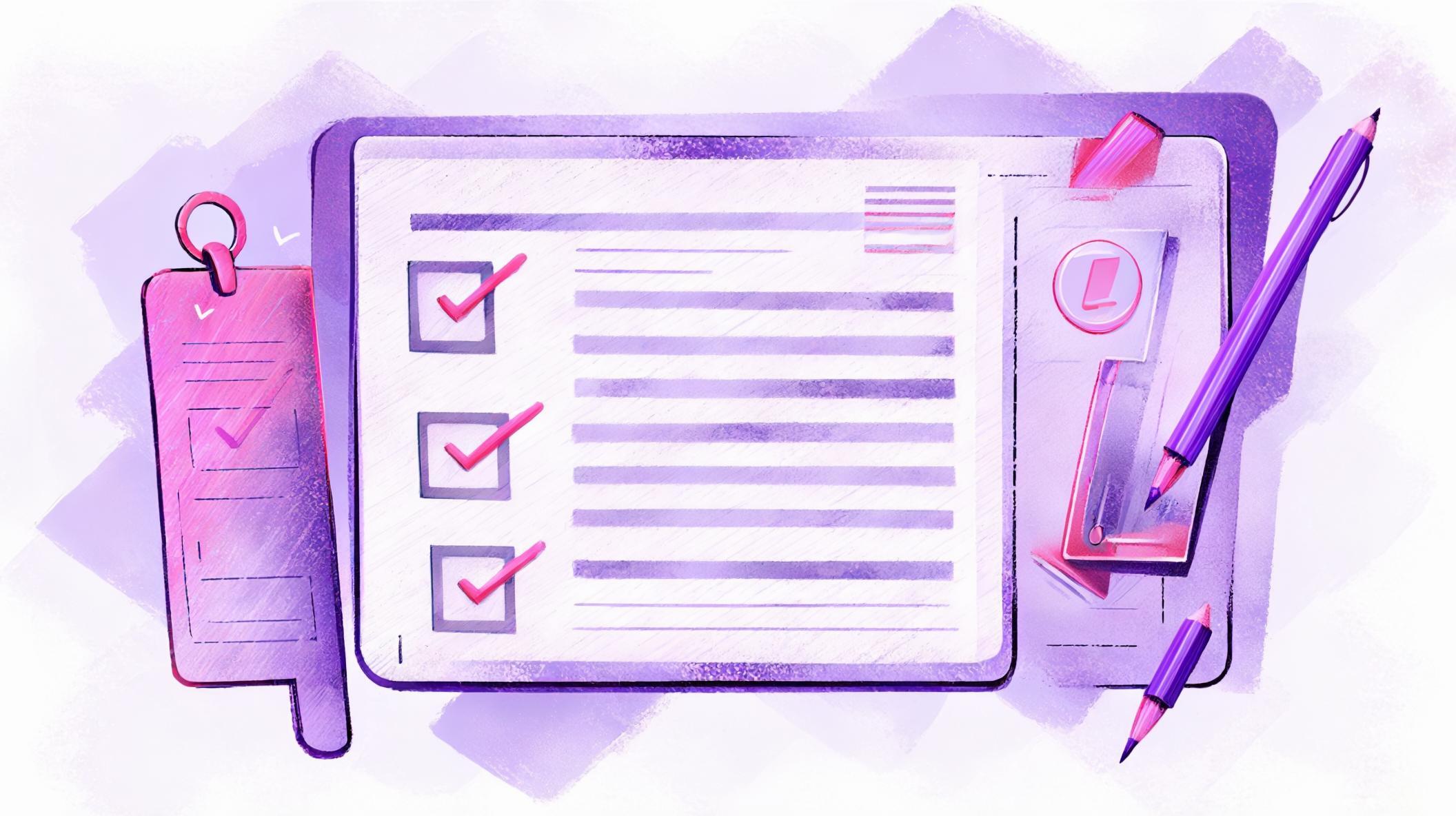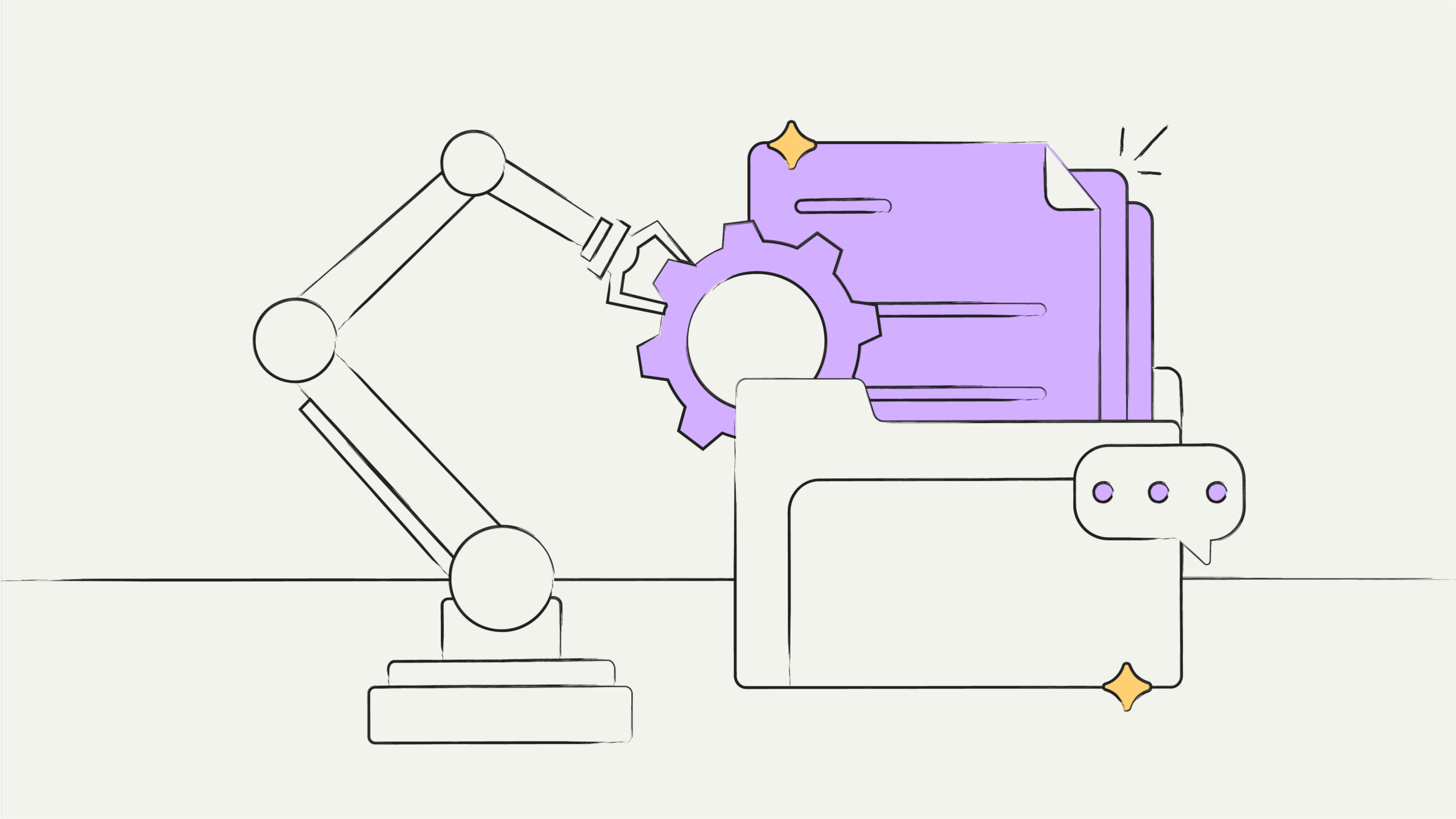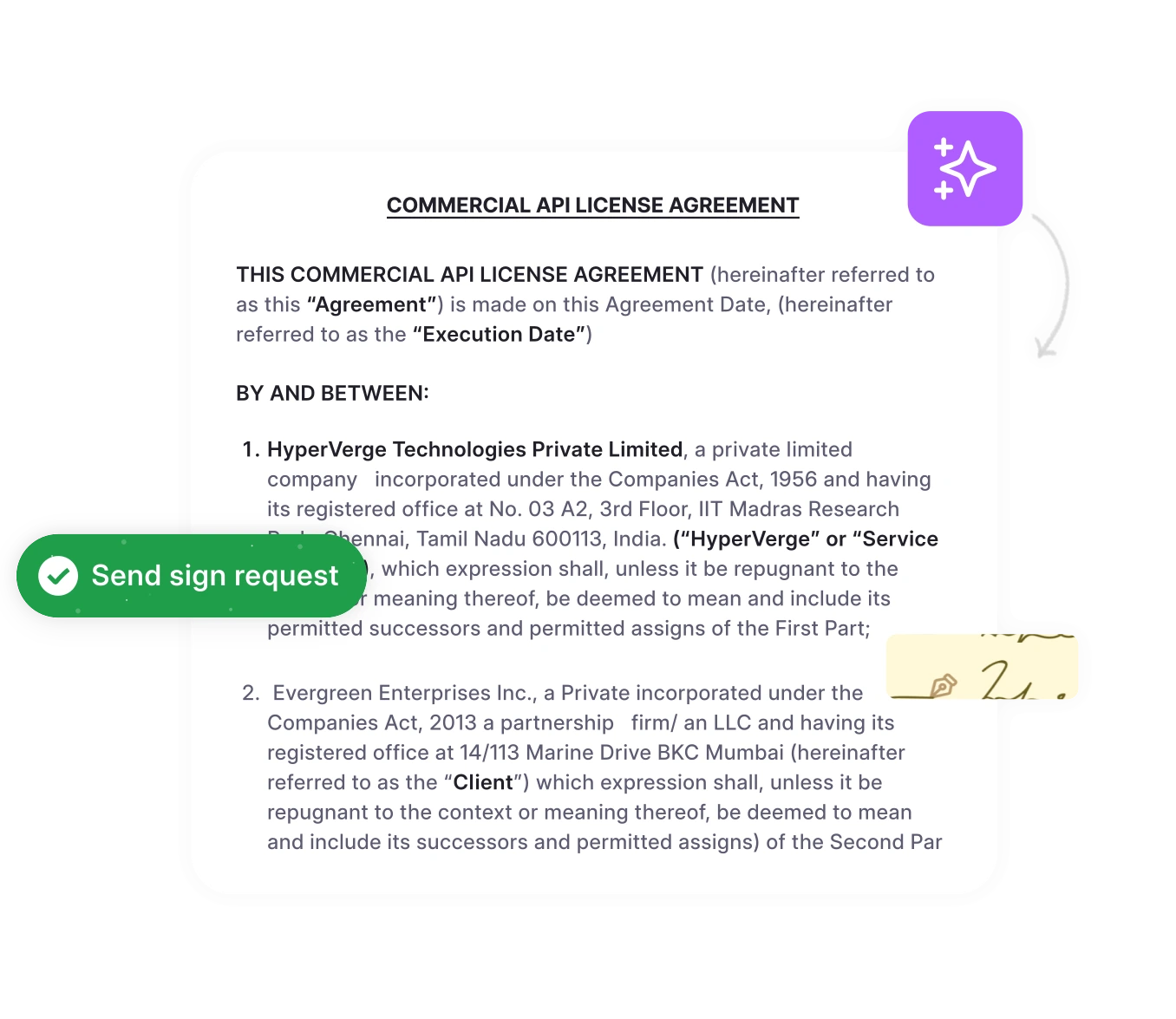Contract creation is a critical stage in the contract lifecycle management process. A well-crafted contract safeguards deals from legal loopholes and ensures faster execution with minimal back-and-forth.
So, what goes into creating a contract, and how do businesses know whether their contract creation process is right? In this blog, we will help you get answers to all these questions and understand contract creation in depth.
This blog encompasses our diverse experience in contract creation. Read to know everything about contract creation—from the basics of creating a contract to processes, best practices, and more. Let’s start.
What is contract creation?
Contract creation is the process of generating a contract, beginning with the initial contract request and concluding when all parties have accepted and signed the agreement.
A streamlined contract generation process is essential to ensure that contracts are free from legal errors and protect the interests of all stakeholders.
Manual contract creation can be time-consuming and labor-intensive. Legal teams must navigate a lengthy procedure to ensure the final agreement meets legal and business requirements.
Wondering what this process is? Let’s find out.
5- Step process of creating contracts
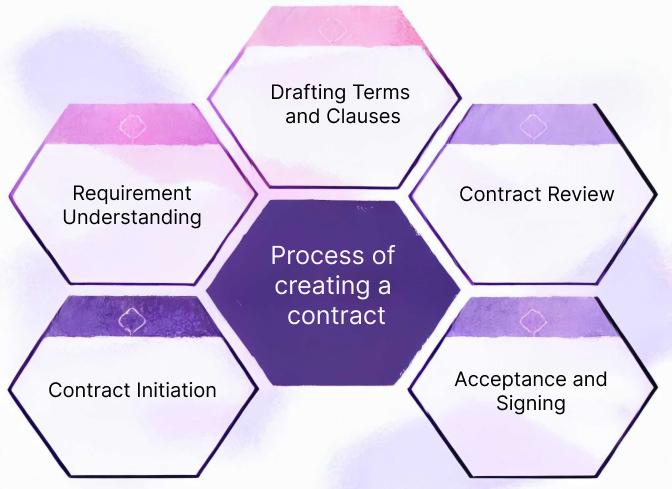
1. Contract initiation
The process of creating a contract starts with contract initiation. Here a request for a contract is generated within the organization, usually by departments like sales, HR, and procurement. The contract request stage means that two parties have agreed upon a deal and want to bind it through a legal agreement.
2. Requirement understanding
Once the contract request is generated, the legal team understands the deal clearly. This means understanding the deal’s terms, conditions, deliverables, involved parties’ interests, etc. Here are some questions that you can ask to understand contract requirements:
What is the context and purpose of this contract?
How is it in the best interest of your organization?
After carefully considering the contract requirements, the legal professionals start writing the contract.
3. Drafting terms and clauses
This is the start of the contract creation process. Here legal professionals write the contract’s terms and clauses based on its requirements. The terms and clauses depend on factors like contract type, usage, risk level, etc. It’s also crucial to keep the contract free from legalese and jargon to prevent risk and misinterpretation.
Careful consideration during the contract drafting process helps avoid legal oversight and ensures that the contract contains all the necessary clauses and terms for executing the agreement.
4. Contract review
Once drafted, the contract is reviewed by the parties involved. First, internal business stakeholders review, redline, and revise it. This involves the contract manager and other respective functional heads.
After an internal review, the contract is sent to the counterparty for review. The counterparties often negotiate the contract’s amount, payment terms, milestones, deliverables, and other clauses at this stage.
5. Acceptance and signing
The agreement is accepted once both parties agree to the contract’s clauses and terms. To complete the contract signing process, stakeholders must sign the contract, bringing it into force.
Relevant laws and jurisdictions regulate signed contracts. Once signed, contracts are stored in contract storage mechanisms like repositories, filing cabinets, and drives.
This is the step-by-step process of creating contracts. However, there are many challenges to this process. The coming section will shed light on these challenges.
4 Common challenges in traditional contract creation processes
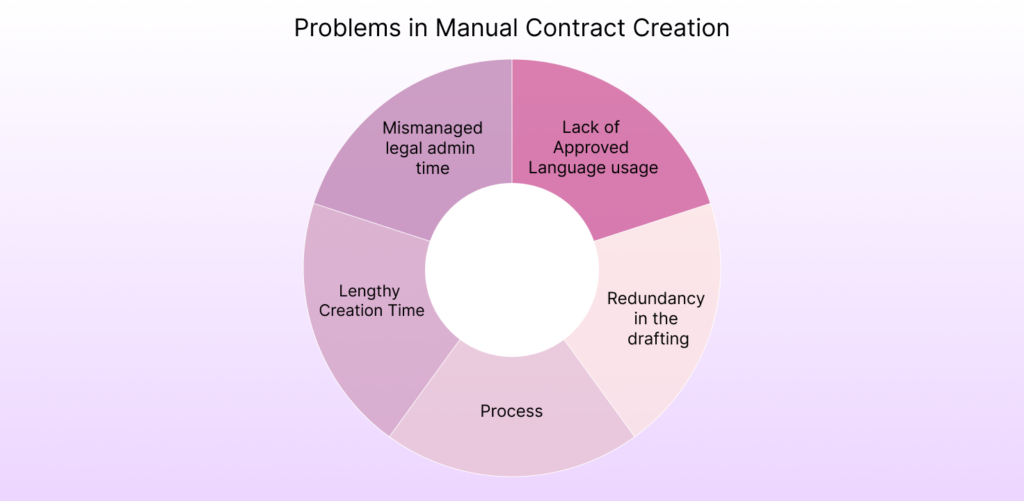
Creating contracts manually can be inconsistent, redundant, wasteful, and error-prone. Let’s find out how.
1. Inconsistent language
Starting from scratch for every contract requires legal resources every time. As contract volumes increase, legal requests begin to sprawl.
The contract language would need to be meticulously reviewed with each clause and term checked to ensure alignment with the contract’s objectives and organizational frameworks.
2. Redundancy in the drafting process
The process of re-drafting every time for standard agreements is redundant. The legal team has to follow each step every time a new contract request is generated, slowing down the process and eventually extending the contract lifecycle.
3. Lengthy creation time
The traditional contract creation process is lengthy and requires follow-up at each contracting step. This delays contract releases, increases contract Turnaround Time (TAT), and hampers the overall contract lifecycle.
4. Misdirected legal resources
Contract admin time refers to a business’s time administering and managing contracts. Traditionally, creating a contract leads to more time spent on contract administration, leaving legal teams less time for other important work.
These are the challenges of creating contracts through traditional processes. You can overcome these challenges by automating contract drafting through a smart, efficient, and reliable contract creation software solution. Let’s take a look at the benefits of automated contract creation.
What are the benefits of automating contract creation?
Contract creation tools like the one from HyperStart help create contracts efficiently and precisely. Enriched with AI technology, these tools are ideal for automating the contract creation process. Let’s take a look at the benefits of such tools.
1. Speeds up contract generation
Automation helps skip redundant parts of the contract creation process and enables legal teams and non-legal professionals to self-serve contracts in just a few clicks. Tools like HyperStart streamline contract creation management by helping create legally binding contracts with approved contract templates, standard clause libraries, and AI chatbots within minutes.
2. Reduces chances of drafting errors
Drafting contracts manually often leads to negligence in contract writing—resulting in contract disputes. Automation, on the other hand, helps streamline contract creation and minimize contract drafting errors. It uses pre-approved clause libraries and templates with standardized contracting language that your organization prefers. This further improves precision, guaranteeing adherence to specific internal compliance policies and governing laws.
3. Helps self-serve contracts in bulk
Sales, procurement, and HR teams frequently require contracts. Automation helps these teams self-generate business contracts without any assistance from the legal team. Sales teams can rinse and repeat pre-approved contracts without leaving their CRM. Procurement and HR teams can create high-volume, low-complexity contracts in bulk. Smart intake forms help easily generate standard contracts like NDAs and MSAs.
4. Faster contracting cycles
Creating contracts faster helps accelerate other parts of the contract lifecycle management process like counterparty review, redlining, and negotiation. The faster your contracts are generated, the quicker the counterparties can review them, which helps accelerate contract workflows.
5. Increases contract language consistency
Using consistent contract language helps ensure that you create a legally binding agreement that is free from legal loopholes and can be quickly reviewed. Automating contract drafting with AI helps promote legal language usage by enforcing playbooks and contract templates.
Using a contract template helps ensure that your contracts are consistent and legally sound while also ensuring speed in contract generation.
Skip Routine Drafts and Focus on Real Opportunities
With self-served drafting, dynamic templates, smart intake forms, and conditional logic, try HyperStart for efficient contract creation.
Automating contract creation benefits the contract lifecycle and other business processes. However, you need an advanced contract generation system like HyperStart to automate contract creation.
In the coming section, we will discuss the core features and functionalities of HyperStart’s contract creation solution.
Functionalities of HyperStart’s contract creation software
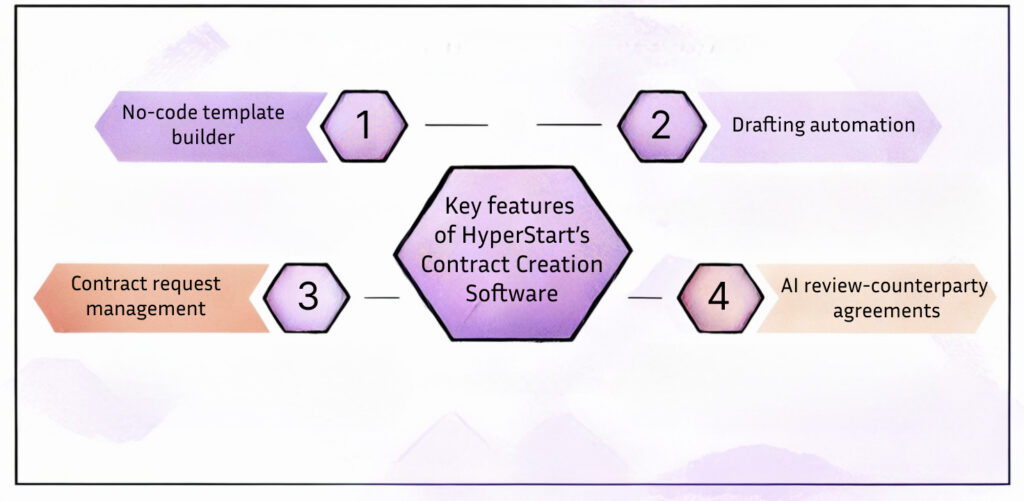
HyperStart’s contract management platform is built using a world-class AI engine that helps automate contractual processes with 95% precision. This agreement generation solution enables you to build new contracts from scratch within 2 minutes, offering great agility and efficiency to your CLM processes.
1. No-code template builder
The no-code template builder helps create customized contract templates and clauses for your business’ contractual processes. This feature helps standardize complex contracts like sales agreements, NDAs, MSAs, etc. for faster contract generation.
Enriched with simple editing functionalities, the no-code template builder equips non-legal teams with automated tools to create external (for example- sales agreements) and internal (for example- employment contracts) contracts and accelerate contractual processes.
2. Drafting automation
Set dynamic conditions and fields for internal and external teams to accelerate quick and automated contract drafting. This feature helps manage high-volume contracts like NDAs, MSAs, and employment contracts with company-specific terms.
The if-then logic of custom fields and conditions helps ensure that your contracts maintain flexibility and speed.
3. Contract request management
Manage large volumes of contract requests through smart intake and contract request forms. The intake form helps customize clauses and contract terms based on specific requests of different departments, thus streamlining contract creation with contract requests.
4. AI review for counterparty agreements
Deploy AI to review your counterparty’s contract agreement and efficiently accelerate the contract review and creation process. This feature automatically flags suspicious clauses for manual review, making the counterparty contract review process fast, efficient, and precise.
Create New Contracts in 2 Minutes
Accelerate your contract drafting speed with AI and experience lightning-fast contract creation with HyperStart’s contract automation solution.
4 Best practices for optimized contract creation
1. Conduct routine checks on templates
Templates are useful for standardizing agreements and accelerating contract drafting. However, it is important to routine-check contract templates to ensure that clauses and terms are updated as per the latest compliance standards.
Routinely checking and updating contract templates helps ensure that all the clauses align with the latest contract laws, business interests, and contract objectives. This enables businesses to secure high-value projects while maintaining consistency, efficiency, and compliance.
2. Standardize contract creation through playbooks
A contract playbook helps standardize contracts by outlining the protocols for contract creation. As per a survey by EY Law, 69% of organizations don’t follow a contracting playbook to draft contracts.
This often results in inconsistencies and agreement disputes. Playbooks cover best practices, guardrails, and approved processes for creating contracts—balancing drafting speed with quality and consistency.
3. Peer review contracts for improved accuracy
Peer reviewing created contacts helps identify and rectify faulty clauses before they are executed. This further streamlines the contract review process and helps accelerate agreement signing.
4. Integrate with legacy systems for connectivity
Connecting your contract creation software with legacy systems like CRMs, HRMs, vendor management systems, and ERPs helps streamline contract generation. Tools like HyperStart’s contract creation software work well with other systems, empowering business teams to self-serve routine contracts compliantly.
Follow these best practices to streamline contract creation and maintain consistency in the contract lifecycle management process. All you need now is an effective contract creation tool that helps generate contracts effectively.
Create new contracts in 2 minutes through HyperStart
Accelerate your contractual processes and improve agreement consistency with HyperStart’s contract creation software. Best suited for procurement, HR, and sales contract management teams to auto-pilot routine contracts without legal dependence. LeadSquared, a B2B SaaS leader, reduced contract creation time by 60% and saved 6+ hours per review with HyperStart. Here’s why our contract creation software is unique:
Auto-pilot for routine contracts
Easy contract sharing for better collaboration
Smart field tagging that improves contract searchability
AI-powered contract summaries for faster reviewing
Diverse signing options that accelerate the contract’s execution
Our contract creation tool comes with a 95% accurate AI model—enabling automation, efficiency, and precision at every stage of contract generation. Schedule a CLM demo with our team today to learn more.
Frequently asked questions
Contract creation is the overall process of generating a contract. It includes understanding the contract’s requirements, analyzing involved parties’ interests, and creating an agreement that fulfills the contractual objectives.
Conversely, contract drafting is only part of the contract creation process. It involves writing the agreement and drafting clauses.



